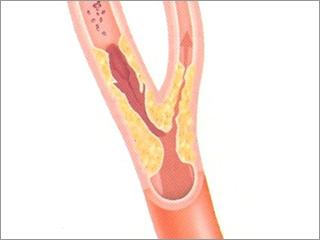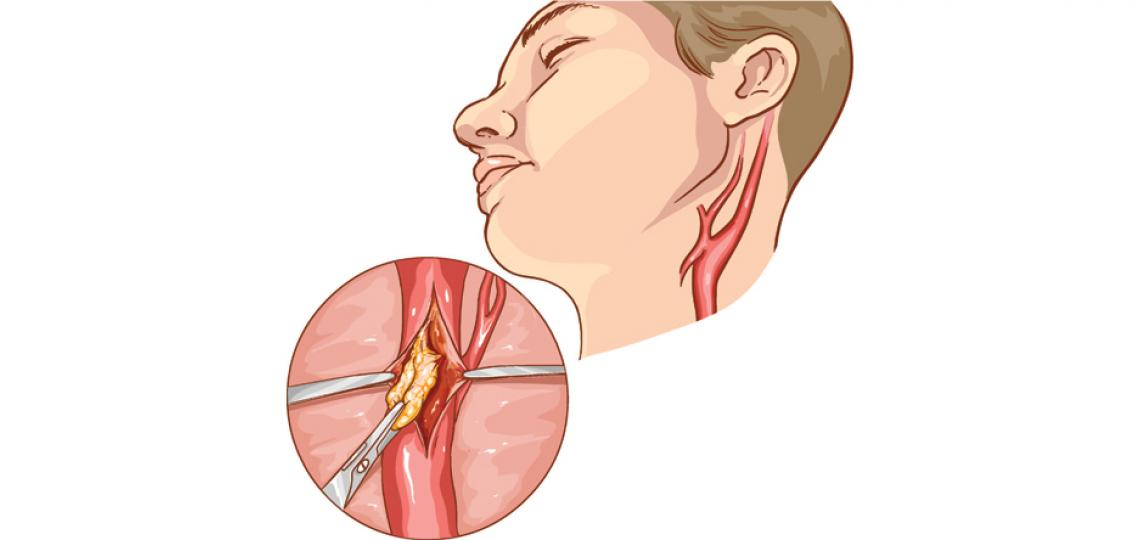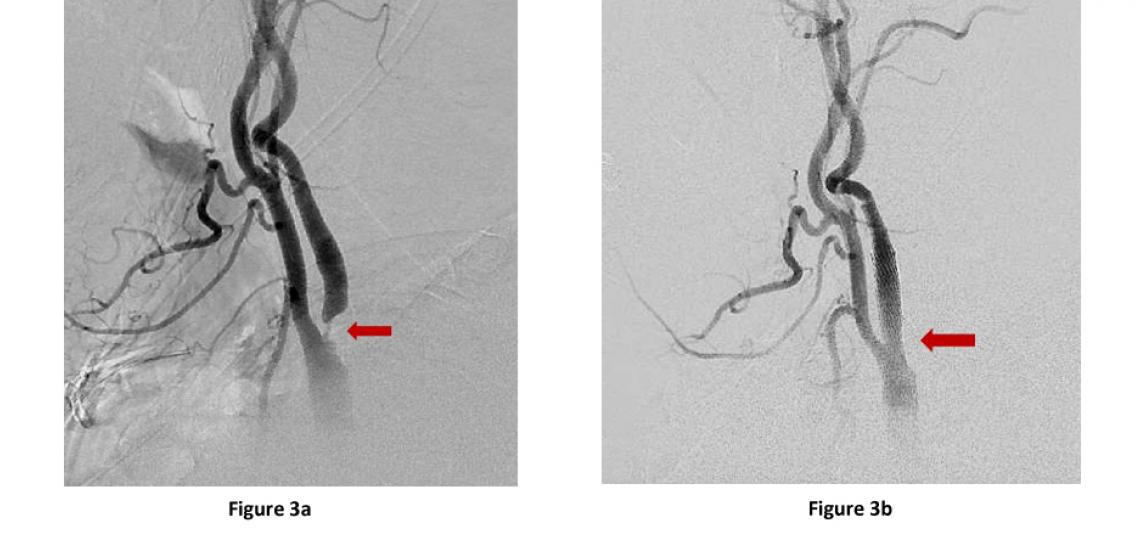What Is Carotid Stenosis?
The most common cause of carotid artery narrowing is a buildup of plaque in the arteries due to multiple risk factors such as smoking, high cholesterol, high blood pressure, family history and diabetes. This is the same disease that affects the vessels in the heart and can result in heart attacks and in leg vessels resulting in poor blood flow. Carotid stenosis is also known as carotid disease and carotid atherosclerosis.
The cerebrovascular neurosurgeons at Baylor Medicine and Baylor St. Luke’s Medical Center in Houston, Texas, specialize in the diagnosis and treatment of carotid disease in and outside the brain. Each patient is different and our doctors provide expertise managing this disorder.

The image to the right (Figure 1) shows an image of a carotid artery in the neck where it divides into the artery of the external carotid artery (smaller vessel on the right) and the internal carotid artery (ICA) leading to the brain (larger vessel on the left). The image depicts the yellow colored plaque buildup inside the walls of the vessel. The image also depicts blood clot forming on the plaque in the ICA (larger vessel on the left), colored in darker red, which can lead to strokes or complete vessel blockage.
Symptoms
The buildup of plaque in the walls of the blood vessel happens slowly over time and may be silent for many years. Often people with carotid artery disease, even with severe narrowing, experience no symptoms. The narrowing is found on a routine physical or an ophthalmological examination. Other times, the narrowing in the carotid can lead to an acute ischemic stroke, which is an emergency and can lead to permanent brain damage. Common symptoms of carotid atherosclerotic disease include:
Transient Ischemic Attacks - An episode of stroke-like symptoms that last less than 24 hours. These symptoms may come and go but mean the patient is at high risk of having a stroke soon.
Acute Ischemic Stroke - Sudden numbness in the face, arm or leg, weakness in the face arm or leg, drooping of one side of the face, slurring of difficulty speaking, difficulty understanding speech, balance difficulty. If you or someone you know is having symptoms of a stroke, call 911 immediately. For more information see acute ischemic stroke.
Visual Changes - Sudden visual changes in one eye may indicate that there is a narrowing in the carotid artery in the neck on that side. The classic description is a "curtain falling" down over the vision and usually returns. This is usually related to low blood flow to the eye or small pieces of the plaque blocking the eye blood supply. Contact your doctor immediately if you or someone you know has these types of visual symptoms.
Diagnosis
Carotid artery disease can be detected multiple ways including:
Bruit - This is a rushing sound in the neck that is often heard by a doctor using a stethoscope during routine physical exams. A high pitch sound or "bruit" coming from the carotid artery may indicate significant narrowing.
Carotid Artery Ultrasound Doppler Scan - This is a noninvasive diagnostic test that uses ultrasound to detect narrowing of the arteries in the neck and can estimate the degree of narrowing or "stenosis."
CT Angiogram or MRI Angiogram - These tests are both able to obtain accurate pictures of the blood vessels in the neck to look for vessel narrowing.
Diagnostic Cerebral Angiogram - This is the most accurate test to determine the presence of carotid stenosis and calculate the percentage of vessel narrowing. However, this test involves a more invasive diagnostic procedure (similar to a heart catheterization) and is often only needed if the other types of tests do not provide clear information.
Outcome of Untreated Carotid Disease
Once a patient has experienced a stroke or TIA from significant carotid stenosis, the risk of a stroke recurring is about 25 percent in two years without treatment. The stroke risk of a patient with asymptomatic carotid narrowing is much lower. In general, the narrower the artery, the higher the risk of stroke.
Treatment
The goal of treatment for carotid artery disease is to reduce the possibility of TIA or stroke, or to prevent the recurrence of a stroke.
Medical Therapy - Medications such as aspirin, other antiplatelets agents (like Plavix), diabetic medications, and medications that lower cholesterol and blood pressure are commonly prescribed when the degree of narrowing is less than 60 percent. Smoking cessation, exercise, and a healthy diet is also important for managing carotid artery disease and preventing further narrowing.
Carotid Endarterectomy - For patients with significant carotid artery narrowing with or without stroke-like symptoms, surgery may be recommended. Carotid Endarterectomy surgery involves exposing the carotid artery in the neck, clamping the artery above and below the plaque buildup, opening up the artery with a knife while it is clamped and directly removing the plaque (Figure 2).
Carotid Stenting - Alternatively, for select patients, carotid angioplasty and stenting, may be recommended. This procedure involves placing a self-expanding stent in the artery at the site of the narrowing and the stent expands holding the artery open (Figure 3), thereby, reducing the risk of future strokes.

Figure 2: Artist depiction of a carotid endarterectomy surgery at the stage where the atherosclerotic plaque is being removed from the artery

Figure 3a: Neck angiogram lateral (side) view of the left carotid artery. There is severe stenosis or narrowing of the internal carotid artery (red arrow) at its origin. Figure 3b: Lateral view of the same patient after placement of a carotid stent showing full re-opening of the stenosis (red arrow).









